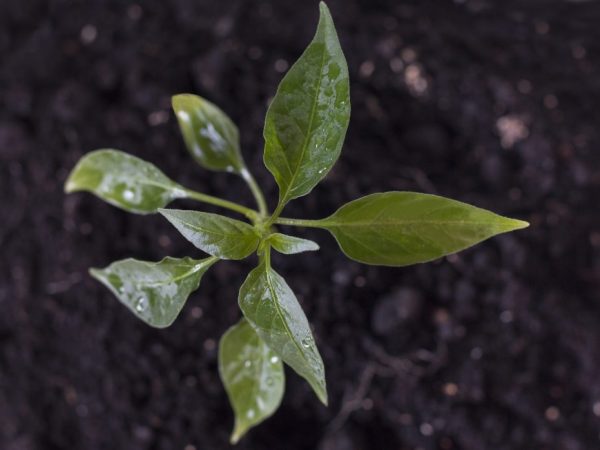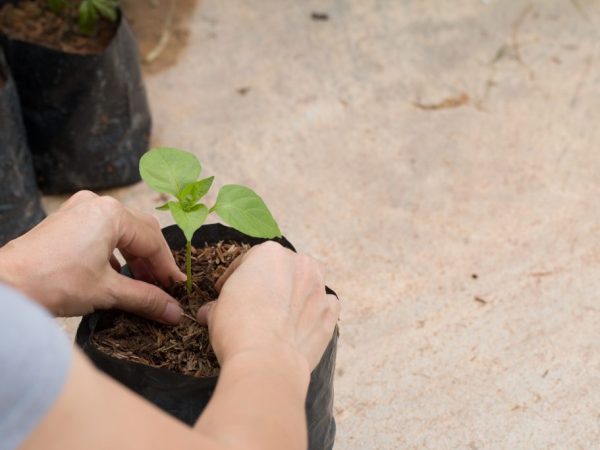Black leg on pepper seedlings
The black leg is quite common in pepper seedlings. Its other name is root collar rot of seedlings. A fungal infectious disease is dangerous for young seedlings and often leads to the death of all seedlings.
- Characteristics of the disease
- Causative agent
- Symptoms
- The main reasons for the appearance
- Contaminated soil and seeds
- Density of plantings
- Excess moisture
- Preventive measures
- The soil
- Seeds
- Seedling
- Treatment of diseased seedlings
- In the initial stages
- In case of mass infection
- Traditional methods
- Prophylaxis
- Treatment

Black leg on pepper seedlings
Characteristics of the disease
In order to identify the black leg on pepper seedlings and begin treatment, it is important to distinguish this fungal infection from other diseases and to know the reasons for its occurrence.
Causative agent
The causative agent of the infection is a fungus that lives in the upper layers of the soil and feeds on dead vegetation. Under certain conditions, the fungus moves to living organisms, feeding on the root parts.
Symptoms
The main symptom is the darkened root neck of the stem. With further development, the fungus leads to a thinning of the trunk and becomes the cause of the formation of a constriction. The plant begins to rot and dies after a while.
At risk are plantings from the first shoots to the appearance of 2-3 leaves.
As a result, young seedlings turn black in 1 week, their stems become soft and break for this reason.
Its danger is that the disease is massive, and in the process of growing seedlings in a small container, it is transferred from diseased sprouts to healthy ones, infecting the entire planting in a short period of time.
The main reasons for the appearance
The reasons for the appearance of a black leg on the stems of peppers lie in the violation of agrotechnical rules, the observance of which is the main measure to combat fungal infection.
Contaminated soil and seeds
Infected soil or seeds of poor quality lead to the fact that the spores of the fungus, which are in the ground or on the seeds, intensify their activity and begin to multiply rapidly.
Density of plantings
Among the provoking factors is the excessive frequency of planting seedlings, as a result of which young shoots do not have enough lighting, the air circulates between the plants poorly, and this leads to a decrease in resistance to fungal infection.
Excess moisture
With frequent and abundant watering, accompanied by insufficient air circulation and sharp fluctuations in ambient temperature, fluid stagnation occurs. This leads to putrefactive processes that contribute to the spread of the fungus. The most common cases of the disease occur in peppers grown in closed greenhouses.
Preventive measures

Preventing fungus
Knowing the source and main reasons for the appearance of blackleg on pepper seedlings, a number of preventive measures can be taken to prevent the development of a fungal disease. The main activities are related to the preparation of seeds for planting.
The soil
Preparing the soil against the black leg includes several stages:
- It is necessary to lower the acidity of the soil to the required level.This is done using ash powder or dolomite flour.
- Disinfect the soil. A hot concentrated solution of potassium permanganate is well suited for these purposes.
- For the greatest efficiency, the land is treated with drugs that have antifungal effect. Among these is Trichodermin.
- Before sowing seed, the soil is abundantly moistened and warmed up to the desired temperature. This is necessary to ensure active germination and full growth and development of blackleg-resistant seedlings.
Seeds
Against a fungal infection, seeds are processed simultaneously with the soil. Such timely disinfection makes it possible to save seedlings from disease. Among biological preparations suitable for these purposes are phytosporin, bactofit, phytoflavin and others.
Seedling
During the period of seedling growth, it is required to treat it against fungal infection by spraying with immunomodulatory drugs that increase the seedlings' resistance to the black leg. Sodium humate, epin and other complexes can increase the immunity of plants.
Treatment of diseased seedlings
To stop the rapid spread of the fungal infection, treatment must be started.
In the initial stages
At the first signs of the presence of a fungus:
- water the seedlings with a weakly concentrated solution of potassium permanganate,
- loosen the soil by hilling the seedlings near the root collar,
- move containers with seedlings apart from each other at a sufficiently large distance,
- Sprinkle the soil on top with copper sulfate mixed with ash powder in a ratio of 1 small spoon per 200g.
In case of mass infection
In case of mass infection of pepper seedlings with a black leg:
- remove and burn all affected seedlings,
- Spill the remaining healthy seedlings with phytosporin, diluted at the rate of 100 ml per 10 liters of water, repeating the spraying treatment at the stage of grown 2-3 leaves, while phytosporin can be replaced with Bordeaux liquid with a concentration of 1%,
- make a pick of healthy seedlings into fresh containers filled with disinfected soil,
- Place containers with preserved seedlings in a warm place, while shading the plantings from direct sunlight.
Traditional methods
Prophylaxis
Experienced summer residents advise first freezing the earth or calcining it in the oven to kill fungal bacteria. However, we must not forget that in the process of hypothermia or overheating of the earth, it loses useful organisms too, which makes it lifeless.
For the purpose of prevention, daily dusting of the soil and seedling necks with powdered charcoal or river sand is also done.
Treatment
A soda solution is prepared for diseased seedlings. For it you will need 200 ml of water and 1 tsp of baking soda. Pepper seedlings are sprayed with this solution.
Some gardeners use onion peel for treatment, from which a decoction is made, calcium nitrate is added to it, and plantings are treated with this mixture. For 1 liter of broth, 2 g of saltpeter is required.


